How to Help Dogs With Travel Anxiety – 10 Effective Solutions to Calm Them
Dogs with travel anxiety can feel scared and upset during trips. This issue is common, but you can help your furry friend. Some dogs get nervous because of the moving car or being in a small space like a crate.
They might bark more, shake, or not want to eat. To make trips better for them, training and certain tools are key. Using crates, carriers, and harnesses makes dogs feel safe. Slowly getting them used to car rides helps too.
Also, playing music or white noise can calm them down just like it does for people.
Before you leave, giving your dog a good workout can tire them out so they’re more relaxed for the trip. It’s also smart to bring things that smell like home to comfort them. For tougher cases, medicine or natural calming products might be needed but ask a vet first.
You have many ways to make traveling easier for your dog. Ready to find out how? Keep reading.
Key Takeaways
- Start early to help your dog get used to traveling. Use a crate for safety and comfort.
- Giving treats and playing music can make car rides fun for dogs.
- Exercise your dog before trips to calm them down.
- Talk to a vet about using medicine or calming stuff if your dog gets really scared.
- Bringing a friend or not feeding right before travel might also help.
Understanding Dog Travel Anxiety
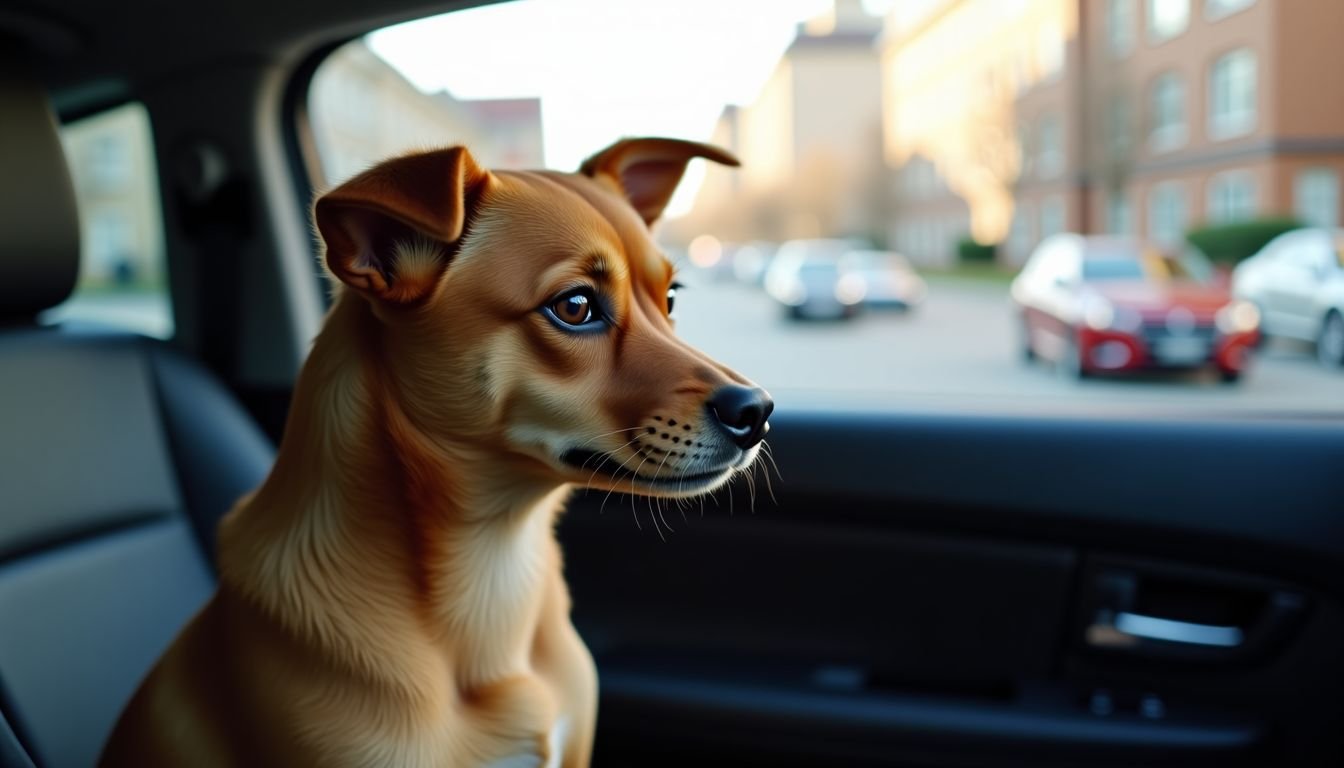
Dogs can feel scared when they travel. This fear may come from loud noises, new places, or past bad experiences.
Causes and Triggers
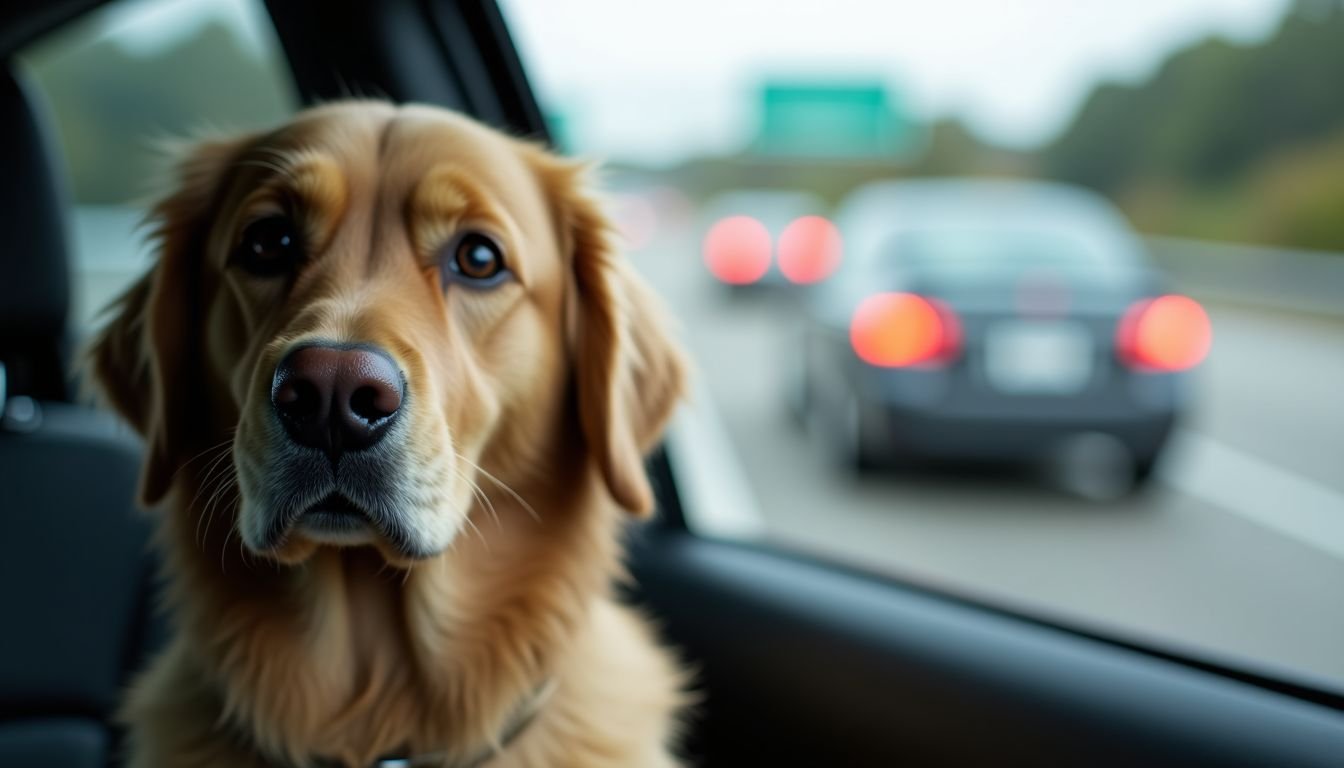
Travel anxiety in dogs can have many causes. Loud noises, strange sights, and new smells often make them nervous. Some dogs may have a past event linked to travel that frightens them.
For example, if a dog got sick during a trip, they might panic at the thought of getting in the car again.
Triggers can vary from dog to dog. Common signs of anxiety include panting and shaking in the car. Your dog’s fear may increase with long trips or busy highways too. A friendly face or familiar sounds could help ease their stress.
Playing soothing music or white noise during travels will create calm surroundings for your pet.
Easing dog’s fear of car rides starts with understanding their triggers.
Symptoms
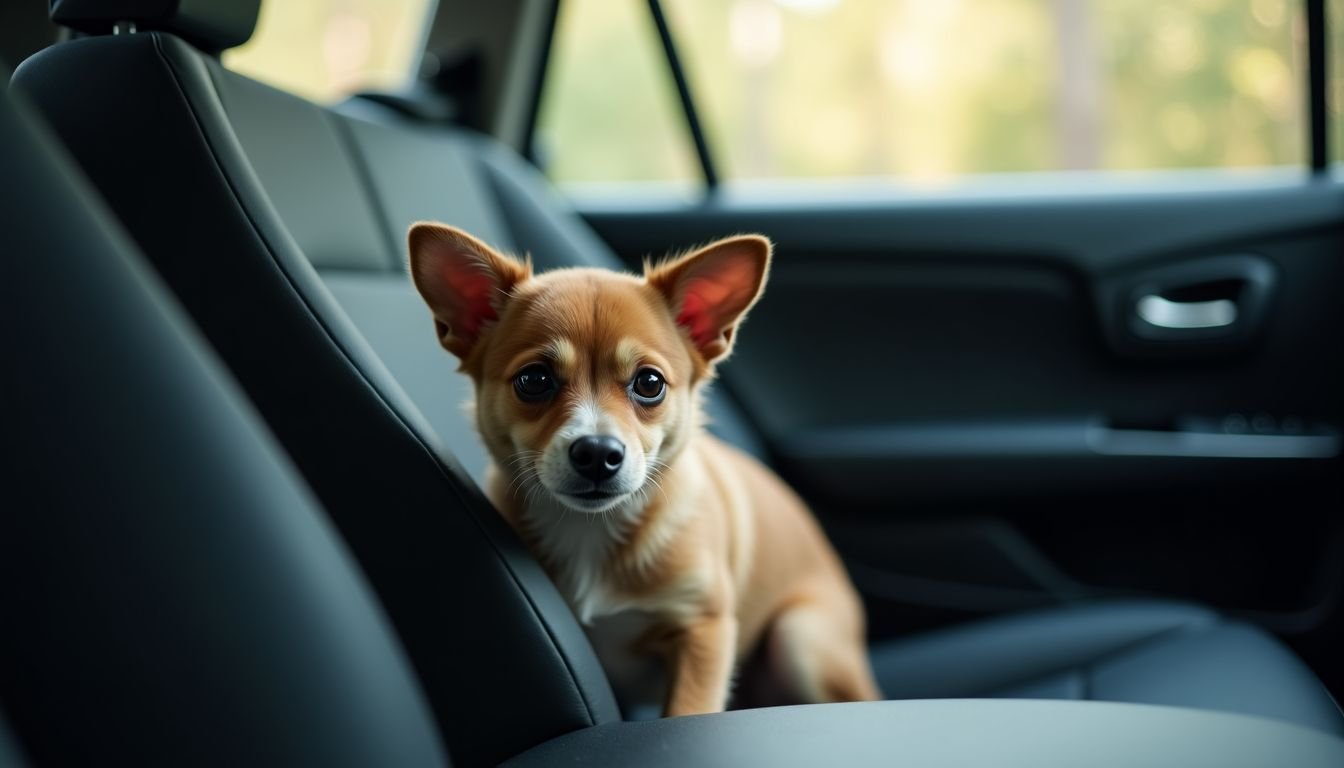
Symptoms of travel anxiety in dogs can be easy to spot. Common signs include panting and shaking during car rides. Dogs may also whine or bark more than usual. Some dogs will hide or try to escape their carriers.
You might notice them drooling excessively or pacing back and forth.
Your dog’s body language can reveal a lot about their feelings. A tucked tail, flattened ears, and wide eyes show fear or stress. These symptoms can make traveling difficult for both you and your pet.
Recognizing these signs early helps you find solutions for canine travel anxiety relief before the next trip begins.
Prevention and Preparation

Prevention and preparation are key to helping your dog feel safe while traveling. Start training early and create a space that makes your pet calm and happy.
Confinement training
Confinement training helps dogs feel secure in their space. It can ease travel anxiety and create a calm environment.
- Introduce the Crate: Start by letting your dog explore the crate at home. Leave the door open so they can go in and out freely.
- Make it Comfortable: Place a soft bed or blanket inside the crate. Add some toys they love to make it inviting.
- Use Treats for Positivity: Reward your dog with treats when they enter the crate willingly. This builds a positive connection with the space.
- Gradually Close the Door: Once your dog is comfortable, start closing the door for short periods. Stay nearby at first to keep them relaxed.
- Practice Short Stays: Leave your dog in the crate for brief times while you are home. Gradually increase this time as they become more comfortable.
- Take Short Car Trips: Begin with short car rides using the crate or a travel harness. This allows your dog to adjust to being confined during travel.
- Create a Safe Environment: Make sure that their travel area feels safe and familiar, just like their crate at home.
- Provide Noise Control: Use calming music or white noise during travels to soothe anxious dogs while confined in their crates.
- Exercise Before Travel: Give your dog about 20 minutes of play before travel trips to help them release energy and relax more easily in their confined space.
- Monitor Their Comfort Level: Watch for signs of stress, like panting or shaking, during training sessions and trips, adjusting as needed based on how they respond.
Following these steps leads to effective pet travel anxiety relief through confinement training, easing your dog’s fear of car rides and managing their anxiety during transport.
Using positive reinforcement
Using positive reinforcement can be a great way to help your dog with travel anxiety. This method builds trust and encourages good behavior.
- Start small: Begin by rewarding your dog for simply getting into the car. Give treats or praise when they show interest in the car.
- Make trips fun: Use treats, toys, and belly rubs as rewards during short car rides. This will create a positive connection with traveling.
- Practice regularly: Take your dog on brief trips around the block. Gradually increase the length of these trips. This helps them get used to being in the car.
- Create a safe space: Set up a comfortable area for your dog in the vehicle, such as using a travel crate or harness. Associate this space with good experiences like toys or treats.
- Be calm yourself: Dogs can sense your emotions. Stay relaxed during travel to help ease their anxiety.
- Use cues: Introduce a special word or phrase that signals “fun time” before you go for a ride—something they look forward to!
- Reward after travels: After every trip, offer high-value treats and praise when you arrive at the destination safely.
- Involve friends: If possible, bring along a buddy for your dog during travels to reduce their stress levels.
- Apply calming music: Play soothing music or white noise while traveling to provide comfort and distraction from outside stressors.
- Gradual desensitization: Slowly expose your dog to longer travel times while consistently rewarding them for calm behavior through snacks or praise.
These positive actions can greatly relieve your dog’s travel anxiety over time while making each journey more enjoyable!
Creating a pleasant environment
Create a pleasant environment for your dog during travel. Use a comfortable travel crate, carrier, or harness to help them feel secure. These tools keep them safe and provide support on bumpy rides.
A familiar item, like their favorite blanket or a cozy bed, can soothe their anxiety. Make this place special by associating it with fun things.
Play calming music or white noise while you travel. Sounds like these can relax your dog and lower stress levels. Exercise your dog about 20 minutes before the trip too. This helps burn off energy and boosts happy hormones called endorphins.
With these steps, you’ll ease your dog’s fear of car rides and make traveling better for both of you.
Solutions for Car Travel Anxiety
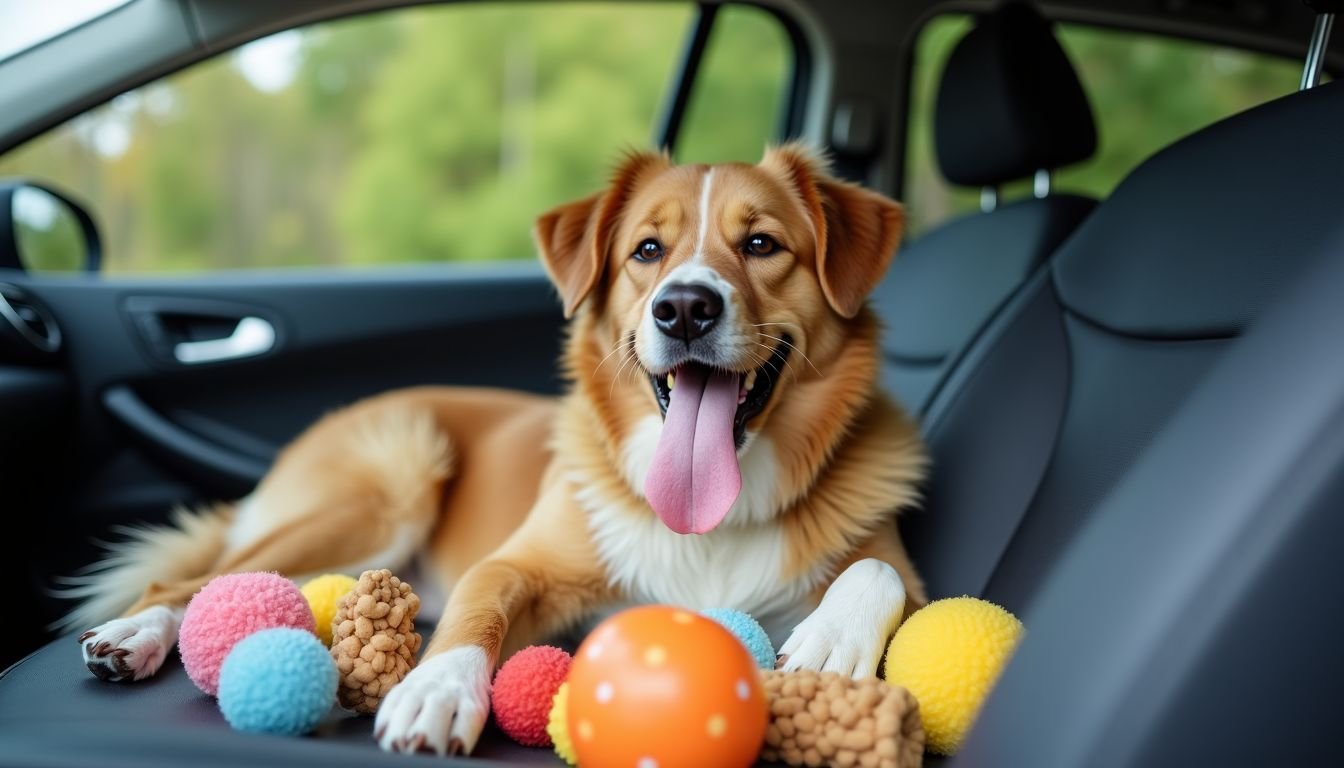
Car rides can be stressful for dogs. You can help your furry friend feel more at ease with the right techniques.
Desensitizing
Desensitizing helps your dog get used to car rides. It can reduce travel anxiety over time.
- Start with short trips. Take your dog on quick drives around the block. Gradually make these trips longer as they become more comfortable.
- Use a travel crate or seat belt. This keeps your dog safe and secure in the car. It can help them feel stable during the ride.
- Practice getting in and out of the car at home. Let your dog explore without going anywhere at first. Offer treats and praise when they do this well.
- Play with toys in the car before a trip. Make it a fun space for them, so they associate it with positive experiences.
- Take breaks during longer trips. Stop every 30 minutes to an hour to let your dog stretch and relax outside of the vehicle.
- Keep calm during car rides yourself. Dogs often pick up on their owner’s emotions, so staying relaxed can help soothe their nerves.
- Create a positive environment inside the car using music or white noise. This can lower anxiety levels naturally and create a calming atmosphere for your pet.
- Exercise your dog before travel time, about 20 minutes of play is great! This gets rid of extra energy and helps them settle down during travel.
Effective training techniques can also assist in managing dog travel anxiety, providing solutions that ease their fear while traveling.
Counterconditioning
Counterconditioning is a helpful way to reduce your dog’s travel anxiety. It changes their negative feelings about travel into positive ones.
- Start with short car rides. Take your dog on brief trips to fun places, like the park. This helps them associate the car with good experiences.
- Use treats during the ride. Give your dog tasty snacks while in the car. This will make them feel happy and calm.
- Play soothing music or white noise. Soft sounds can help create a relaxing space in the car. This can lower stress and make your dog feel safe.
- Gradually increase trip length. Once your dog feels more relaxed, take longer drives step by step. This helps build their confidence over time.
- Provide a safe space in the vehicle. Use a comfortable dog bed or mat for them to sit on. Make sure this spot is linked to nice things like treats and praise.
- Avoid feeding just before travel. Having an empty stomach can help prevent nausea during trips. This keeps your dog feeling better overall when traveling.
- Consult your vet if needed. Sometimes, dogs need extra help from calming supplements or medications for travel anxiety issues.
- Be patient and consistent with training techniques over time as you work through your dog’s fears about traveling.
- Keep practicing these steps regularly for lasting change in behavior toward future trips.
This method of counterconditioning supports other effective solutions, such as desensitizing your dog to fear triggers during travel.
Medication and calming supplements
Counterconditioning can be effective in easing dog travel anxiety. Medication and calming supplements are other options to consider. Talk to your vet before using any medication for your dog.
They can recommend over-the-counter sedatives if needed. These drugs may help calm anxious dogs during travel.
Calming supplements can also support your dog’s well-being. Look for natural remedies, like music or white noise, that may reduce stress levels during the trip. Exercise is useful too; taking a 20-minute walk before traveling can tire them out and boost their mood.
A safe spot, like a comfortable bed or mat, makes them feel secure while traveling in the car.
Using these methods will help you manage dog anxiety in car journeys better and make trips easier for both of you!
Alternative Solutions
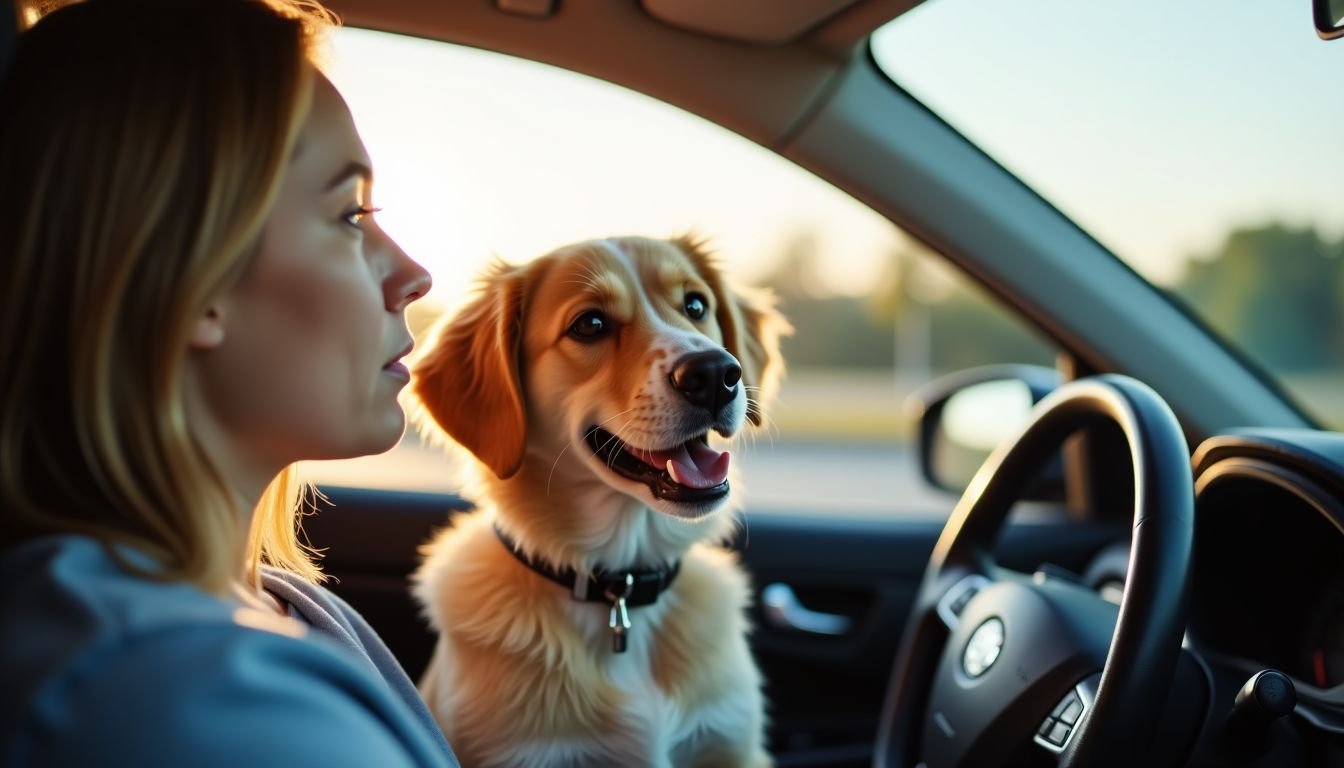
5. Alternative Solutions: There are many ways to help your dog feel better during travel. You can use barriers to block sights that stress them out. Or, you might want to remove barriers so they can see outside.
It’s best not to feed your dog right before the trip. Bringing a friend along can also help calm your pup down. Want more ideas? Keep reading!
Using visual barriers
Visual barriers can help ease dog travel anxiety. Using a crate or carrier can make your dog feel safe in the car. These tools keep your dog secure and prevent distractions while you drive.
You can also use covers on windows to block outside sights. This reduces things that might scare or stress your dog.
Creating a calm space is key for easing dog’s fear of car rides. Soft blankets or familiar toys inside the crate can soothe them during trips. Music or white noise may also reduce their stress levels while traveling.
By using visual barriers, you support calming solutions for dog travel anxiety effectively.
Removing visual barriers
Removing visual barriers can help relax anxious dogs during travel. Dogs often feel stressed when they see fast-moving objects outside the car. Blocking their view can ease this stress.
You can use window shades or dog seat covers to create a calm space inside the vehicle.
Making your dog comfortable is key. A familiar blanket or bed placed in their crate can provide a safe spot. This connection helps ease anxiety while traveling in the car. Discovering ways to soothe your dog’s travel nerves will lead you to other helpful tips for managing dog car anxiety effectively.
Not feeding your pet before travel
Not feeding your pet before travel can help reduce anxiety. A full stomach can lead to car sickness or discomfort. If you skip their meal, they may feel lighter and more comfortable during the trip.
Exercising your dog for about 20 minutes before you go helps burn off energy and releases happy hormones called endorphins. This will also make them calmer while traveling.
Bringing along a favorite toy or blanket can create a sense of security. Provide a safe place in the vehicle, like a cozy bed or mat, where they feel relaxed. Dogs that pant or shake during trips often show signs of travel anxiety.
Taking these steps eases dog anxiety during trips and makes car rides more enjoyable for both of you.
Bringing a friend along
Sometimes, it helps to bring a friend along for the ride. Having another dog in the car can soothe your anxious pet. A calm buddy can make travel feel safe and more enjoyable.
If their friend is relaxed, your dog may mirror that behavior. It’s like having a travel buddy who understands them. This simple step can ease dog anxiety while traveling. If you have room, let them share the space together for comfort and support during trips.
Air Travel with Anxious Dogs
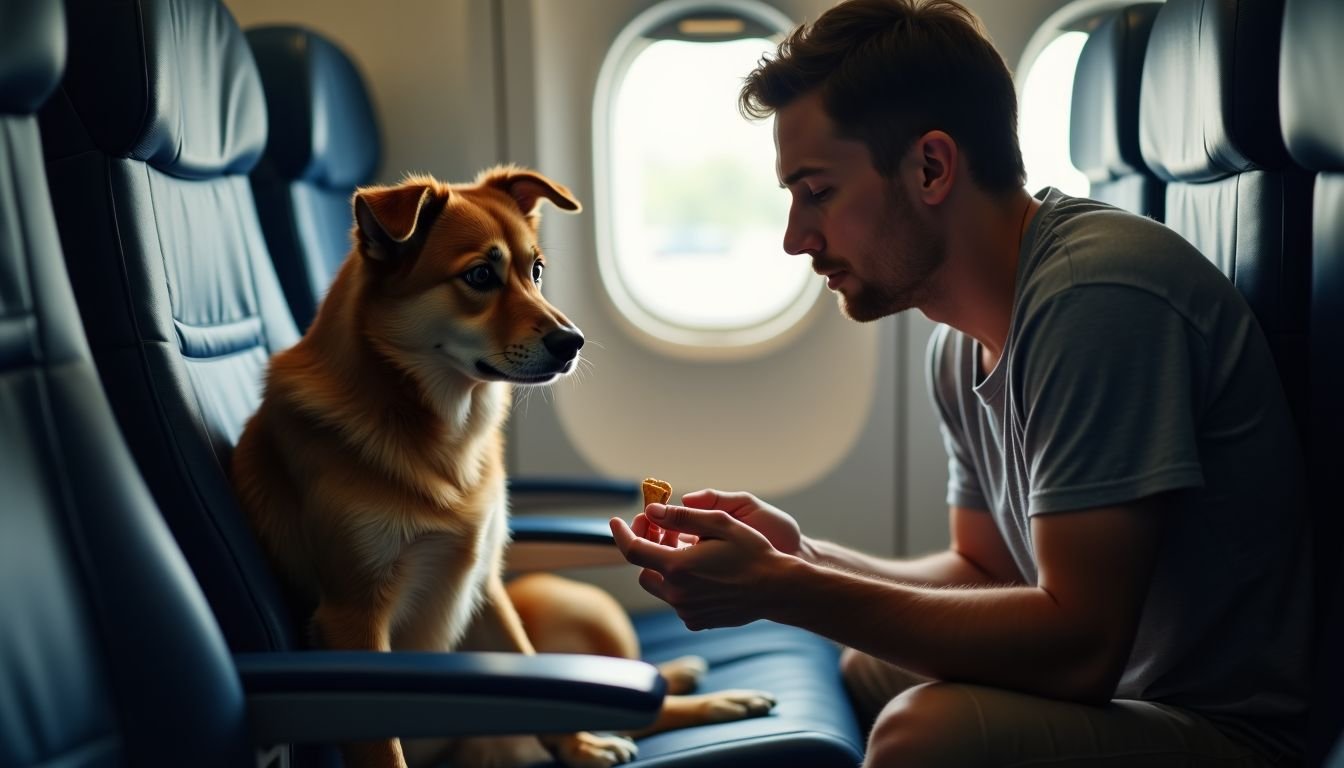
Air travel can be tough for anxious dogs. You need to prepare them well and have the right gear to help make the trip easier.
Preparation and training
Preparation and training are key for helping your dog with travel anxiety. A few simple steps can make a big difference in your dog’s comfort.
- Create a safe space for your dog. Use a travel crate, carrier, or harness. This helps them feel secure during trips.
- Practice short car rides first. Start with five to ten minutes in the car. Gradually increase the time to help your dog get used to longer drives.
- Let your dog play before the trip. Exercising for 20 minutes can release endorphins and tire them out, making it easier for them to relax.
- Use positive reinforcement during training sessions. Reward your dog with treats when they stay calm in the car.
- Train your dog to enjoy their crate or space by providing a comfortable bed or mat inside it. Associate this area with fun things like toys and treats.
- Play calming music or white noise while driving. This can soothe their nerves and create a peaceful environment.
- Keep feeding times in mind before travel. Avoid feeding your dog just before hitting the road to prevent motion sickness.
- Bring along a friend if possible during trips with an anxious dog. Familiar faces can help reduce stress levels.
- Consult with your vet about medications if needed. Over-the-counter sedatives may help but always check first for safety.
- Train consistently and keep practicing until traveling becomes routine for you both.The goal is to ease their fear over time, resulting in better trips together!
Necessary equipment and documents
Traveling with your dog requires some key equipment and documents. These items help make the journey smoother and safer for your pet.
- Travel Crate or Carrier: A travel crate gives your dog a secure place to stay. It helps them feel safe during trips. Choose one that is well-ventilated and sturdy.
- Dog Seat Belt or Harness: This device keeps your dog secure in the car. It prevents sudden movements that can cause injury during travel.
- Comfort Items: Bring along your dog’s favorite bed or mat. This can create a safe zone filled with familiar smells, helping to soothe anxiety.
- Vaccination Records: Always carry your dog’s vaccination records. Some places may require proof of vaccinations before allowing entry.
- Identification Tags: Ensure your pet wears an ID tag with updated contact information. In case they get lost during travel, they can be easily returned to you.
- Medications and Supplements: Pack any medications or calming supplements prescribed by your veterinarian. Consult with them about using over-the-counter sedatives if needed.
- Water Bowl and Portable Water: Keep your dog hydrated during trips. A portable water bowl makes it easy to offer water whenever necessary.
- First Aid Kit for Dogs: Prepare a basic first aid kit for emergencies on the road. Include items like bandages, antiseptic wipes, and any specific items recommended by your vet.
- Leash and Muzzle: Bring a strong leash for walks at rest stops or new areas. A muzzle may be useful if your dog tends to get nervous around strangers.
- Documents for Air Travel: If flying, check what documents are needed for air travel with pets, like health certificates or breed restrictions specific to airlines.
These essentials will help calm anxious dogs during travel and ensure a safer experience overall.
Alternative solutions for those who don’t have time to train
Some quick solutions can help your dog with travel anxiety, even if you don’t have time to train. Natural remedies like music or white noise can create a calming space for your dog during trips.
These sounds often soothe anxious dogs and lower their stress levels.
Using a travel crate or harness can also provide some comfort. They make dogs feel secure and keep them steady on the road. If possible, try not to feed your pet before traveling. An empty stomach may prevent car sickness and help reduce nervous energy.
Bringing along a friend who is calm around dogs can make the ride easier too. This extra company might help alleviate your dog’s travel nerves while adding fun to the trip ahead.
Next, let’s look at air travel with anxious dogs and how best to prepare them for flying.
Additional tips for reducing stress during air travel
Air travel can be stressful for dogs. It’s important to take steps to make the journey easier for them.
- Use a travel crate or carrier. This helps your dog feel safe and secure during the flight. A familiar space can calm their nerves.
- Keep their favorite blanket or toy with them. This gives them comfort and a sense of home while in an unfamiliar place.
- Exercise your dog before flying. A good walk of about 20 minutes helps burn off energy and releases happy hormones, making them more relaxed during travel.
- Play soft music or white noise before and during the flight. Both sounds create a calming atmosphere that reduces anxiety levels for dogs.
- If possible, schedule non-stop flights. Fewer stops mean less stress for both you and your pup.
- Bring plenty of water and some snacks, but avoid feeding right before traveling. Having water on hand helps keep your dog hydrated without worrying about motion sickness from a full stomach.
- Make sure all documents are in order ahead of time. Knowing you have everything ready means less stress for you, too.
- Arrive early at the airport to avoid rushing around. It allows you to take your time when checking in with your pet and reduces last-minute anxiety.
- Calmly engage with your dog throughout the flight instead of ignoring them completely, which may increase their stress levels.
- Consult with your vet about medications or calming supplements if needed but don’t forget to check well in advance.
Taking these steps will help ease dog anxiety during trips by creating a calmer environment for air travel.
Next, let’s dive into air travel preparation and training so you can set up both you and your furry friend for success!
Conclusion
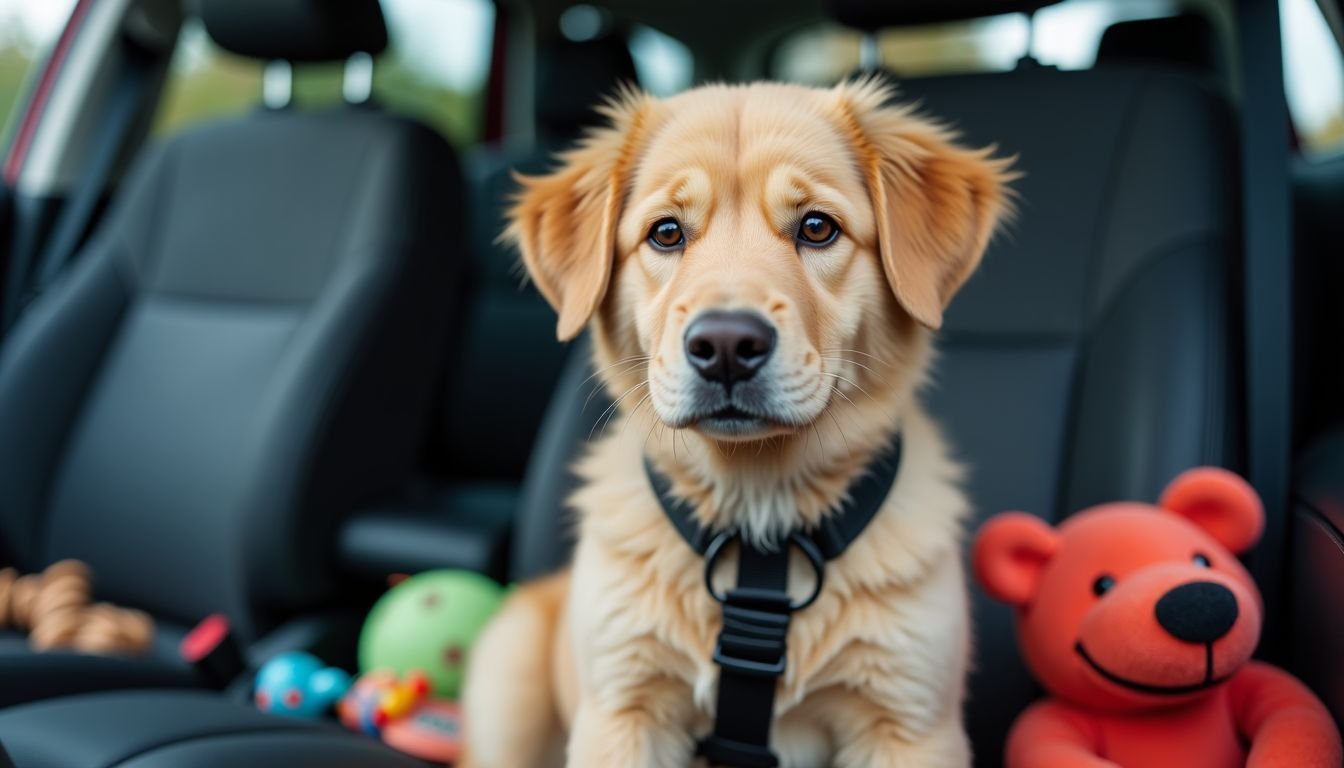
You can help your dog with travel anxiety. Many dogs get scared when they have to travel. They may shake or pant more. This is common but you can make it better.
First, crates and harnesses are good tools. They help your dog feel safe while moving. Start with short trips in the car and go for longer ones over time. This helps your dog get used to traveling.
Before a trip, exercise is key. It makes them tired and calm in the car. Also, things like their bed or music can make them feel at ease.
There are ways to slowly get your dog used to travelling by car or air if they are scared. Training, meds, and keeping trips happy work well.
For car rides, making the car a happy place works wonders. You can also give them special treats only during travels.
If flying is needed, prepare ahead of time with training and ensure you have all necessary items ready for a smooth journey.
Not feeding before trips might avoid sickness in some dogs too—bringing another pet friend along helps as well!
So try these tips next time you plan on going somewhere with your furry buddy!
FAQs
1. What are some ways to help dogs with travel anxiety?
There are many effective solutions for dogs with travel anxiety, such as calming them during travel, soothing them during car trips and using various methods of dog travel anxiety management.
2. How can I prevent my dog from experiencing travel stress?
Travel anxiety prevention for dogs involves creating a comfortable environment in the vehicle, gradually introducing them to car rides, and using calming techniques like soft music or comforting toys.
3. Can I treat my dog’s car anxiety myself?
Yes, there are several ways you can personally handle your pet’s travel stress including relieving their fear through positive reinforcement and utilizing specific strategies aimed at relaxing anxious dogs during travels.
4. Are there any tips for traveling with an anxious dog?
Certainly! Easing your canine companion’s nerves before embarking on a trip is key to coping with their phobia. This could include short practice drives or creating a familiar space within the vehicle that will help alleviate their anxieties.
5. What do I do if my dog gets nervous during our road trips?
To manage this issue effectively requires patience and understanding of your pet’s needs; it may involve employing certain techniques such as providing distractions or even consulting with a vet about possible medication options if necessary.
editor's pick
latest video
news via inbox
Nulla turp dis cursus. Integer liberos euismod pretium faucibua

